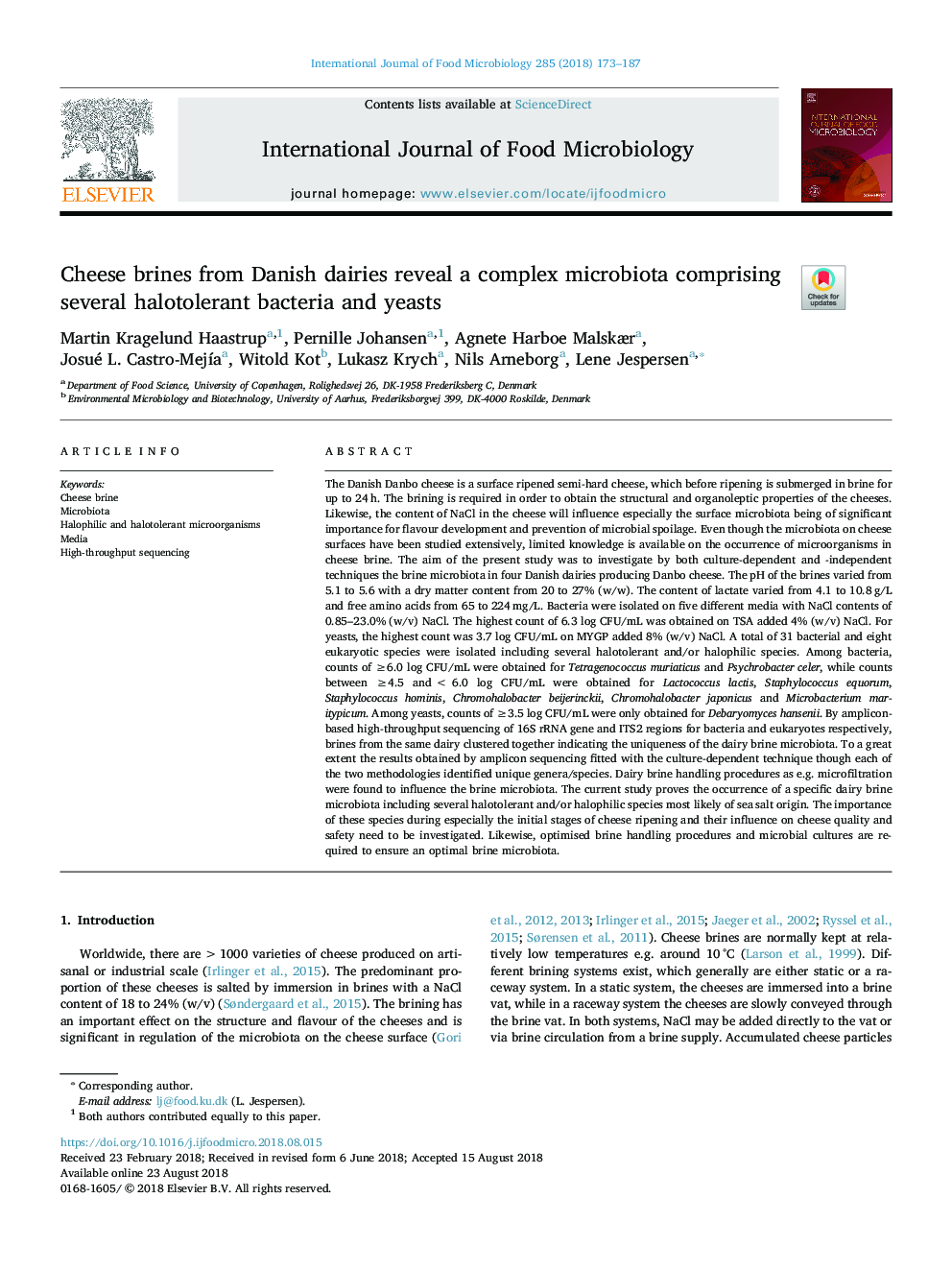| کد مقاله | کد نشریه | سال انتشار | مقاله انگلیسی | نسخه تمام متن |
|---|---|---|---|---|
| 10107133 | 1616498 | 2018 | 15 صفحه PDF | دانلود رایگان |
عنوان انگلیسی مقاله ISI
Cheese brines from Danish dairies reveal a complex microbiota comprising several halotolerant bacteria and yeasts
ترجمه فارسی عنوان
نمک های پنیر از لبنیات دانمارکی یک میکروب بیوتای پیچیده را تشکیل می دهند که حاوی چندین باکتری هالوتولرانت و مخمر است
دانلود مقاله + سفارش ترجمه
دانلود مقاله ISI انگلیسی
رایگان برای ایرانیان
موضوعات مرتبط
علوم زیستی و بیوفناوری
علوم کشاورزی و بیولوژیک
دانش تغذیه
چکیده انگلیسی
The Danish Danbo cheese is a surface ripened semi-hard cheese, which before ripening is submerged in brine for up to 24â¯h. The brining is required in order to obtain the structural and organoleptic properties of the cheeses. Likewise, the content of NaCl in the cheese will influence especially the surface microbiota being of significant importance for flavour development and prevention of microbial spoilage. Even though the microbiota on cheese surfaces have been studied extensively, limited knowledge is available on the occurrence of microorganisms in cheese brine. The aim of the present study was to investigate by both culture-dependent and -independent techniques the brine microbiota in four Danish dairies producing Danbo cheese. The pH of the brines varied from 5.1 to 5.6 with a dry matter content from 20 to 27% (w/w). The content of lactate varied from 4.1 to 10.8â¯g/L and free amino acids from 65 to 224â¯mg/L. Bacteria were isolated on five different media with NaCl contents of 0.85-23.0% (w/v) NaCl. The highest count of 6.3 log CFU/mL was obtained on TSA added 4% (w/v) NaCl. For yeasts, the highest count was 3.7 log CFU/mL on MYGP added 8% (w/v) NaCl. A total of 31 bacterial and eight eukaryotic species were isolated including several halotolerant and/or halophilic species. Among bacteria, counts of â¥6.0 log CFU/mL were obtained for Tetragenococcus muriaticus and Psychrobacter celer, while counts between â¥4.5 andâ¯<â¯6.0 log CFU/mL were obtained for Lactococcus lactis, Staphylococcus equorum, Staphylococcus hominis, Chromohalobacter beijerinckii, Chromohalobacter japonicus and Microbacterium maritypicum. Among yeasts, counts of â¥3.5 log CFU/mL were only obtained for Debaryomyces hansenii. By amplicon-based high-throughput sequencing of 16S rRNA gene and ITS2 regions for bacteria and eukaryotes respectively, brines from the same dairy clustered together indicating the uniqueness of the dairy brine microbiota. To a great extent the results obtained by amplicon sequencing fitted with the culture-dependent technique though each of the two methodologies identified unique genera/species. Dairy brine handling procedures as e.g. microfiltration were found to influence the brine microbiota. The current study proves the occurrence of a specific dairy brine microbiota including several halotolerant and/or halophilic species most likely of sea salt origin. The importance of these species during especially the initial stages of cheese ripening and their influence on cheese quality and safety need to be investigated. Likewise, optimised brine handling procedures and microbial cultures are required to ensure an optimal brine microbiota.
ناشر
Database: Elsevier - ScienceDirect (ساینس دایرکت)
Journal: International Journal of Food Microbiology - Volume 285, 20 November 2018, Pages 173-187
Journal: International Journal of Food Microbiology - Volume 285, 20 November 2018, Pages 173-187
نویسندگان
Martin Kragelund Haastrup, Pernille Johansen, Agnete Harboe Malskær, Josué L. Castro-MejÃa, Witold Kot, Lukasz Krych, Nils Arneborg, Lene Jespersen,
